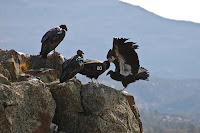Now that I’ve covered a spread of the different animal
species that have been categorised at differing levels of endangerment, I feel
as though I should address a few of the issues that you may be considering at
this point. Whilst I have indeed managed to highlight what is hopefully some
new information that you were unaware of previously, I feel that there is still
plenty to address.
My desire to steer clear of the favoured or more publicised
species that are endangered was not out of a form of preference for those
species that I did report on, but rather a desire to see a more even spread of
focus within the animal kingdom. Tigers, Pandas, Whales; all of these creatures
are, in my opinion, suffering from overexposure – people are so used to seeing
these creatures stamped across leaflets, shoved in their face during television
adverts and furiously campaigned for so often that the general public has almost
become ‘desensitised’ to their plight.
This is not to say that what has befallen this species is
not terrible – I truly understand the need to campaign for and protect these
species wholeheartedly; I merely feel that the large number of other species
that are in trouble require highlighting as well before they quietly slip away
into extinction without anyone noticing due to the spotlight that is currently
illuminating the cause of those famous species, leaving little room on the
world stage of welfare for those other species that in some cases may actually
be in a worse position.
I do not wish to blame the species or insinuate that it is
their fault that other species are suffering, but I do have to blame the fickle
nature of mankind. In saving the ‘prettier’ species, whose plight has been
publicised more, we can sit around and pat ourselves on the back when they
survive, forgetting about the other species that die out behind the ‘blackout
curtain’ of our own media focus. I feel like this is a damning approach to take
when looking at animal conservation and without having our hearts 100%
dedicated to the preservation of every species, we end up spoiling the efforts
we have made in the face of everything that we should have done.
This is not to say that I believe conservation efforts have
not been made. I know full well that every species categorised on the list of
endangered species that is not currently of no concern will have some form of
research being undertaken into how best to help the species. Conservation and
breeding efforts are being made for those species where available, but unless
we reverse the damage that we have done, all we are doing is fighting a battle in
attempting to rewind time and the damage we have caused, a battle that proves
worse for us in the long run – we cannot return species from extinction, so
every day we struggle just to get those species to a stable level.
I hope that this blog has shown the state of species beyond
the marketable ‘core’ of the animal world and that you have seen the need for a
fair spread of animal welfare efforts. Humanity is the driving force behind
some of the most destructive and naturally disruptive actions and effects that
have been wrought upon the wildlife of this earth and it is now left in our
hands to reverse this damage; we need to be dedicated to the cause, otherwise
we will see the extinction of those species that are slowly slipping away day
by day which will sadly mean that, despite our best efforts, our destructive
nature has won out and we are the only species that can be held accountable.
























